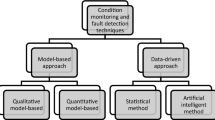Abstract
In the training of radial basis function (RBF) networks, one important issue is to select RBF centers before constructing the networks. Most existing center selection methods are designed for the fault-free situation only. However, as the implementation of the networks may be perturbed by faults, these algorithms may lead to networks with degraded performance. This paper considers the center selection problem for RBF networks under the concurrent fault situation where multiplicative weight noise and open weight fault exist simultaneously. In particular, we introduce a binary label vector indicating the centers selected from training samples. Using the label vector, the fault-tolerant RBF model under the concurrent fault situation is reformulated as a constrained optimization problem, so that fault-tolerance can be considered in the procedure of center selection. To solve this constrained optimization problem, a constrained particle swarm optimization based algorithm is developed to select centers and train the network simultaneously. Simulation results show that the proposed algorithm is superior than state-of-the-art center selection algorithms.









Similar content being viewed by others
References
Burr JB (1991) Digital neural network implementations. In: Neural networks, concepts, applications, and implementations, vol 3, pp 237–285
Chen S (1995) Nonlinear time series modelling and prediction using gaussian RBF networks with enhanced clustering and RLS learning. Electron Lett 31(2):117–118
Chen S (2006) Local regularization assisted orthogonal least squares regression. Neurocomputing 69(4–6):559–585
Chen S, Cowan CFN, Grant P (1991) Orthogonal least squares learning algorithm for radial basis function networks. IEEE Trans Neural Netw 2(2):302–309
Ekambaram R, Fefilatyev S, Shreve M, Kramer K, Hall LO, Goldgof DB, Kasturi R (2016) Active cleaning of label noise. Pattern Recognit 51:463–480
Feng RB, Leung CS, Constantinides AG (2016) LCA based RBF training algorithm for the concurrent fault situation. Neurocomputing 191:341–351
Feng X, Chen GL, Guo WZ (2006) Settings and experimental analysis of acceleration coefficients in particle swarm optimization algorithm. J Jimei Univ 2:146–151
Han Z, Feng RB, Wan WY, Leung CS (2015) Online training and its convergence for faulty networks with multiplicative weight noise. Neurocomputing 155:53–61
Kennedy J, Eberhart R (1995) Particle swarm optimization. In: Proceedings of ICNN’95—international conference on neural networks, vol. 4, pp 1942–1948. https://doi.org/10.1109/ICNN.1995.488968
Kennedy J, Eberhart R (2002) Particle swarm optimization. In: ICNN’95-international conference on neural networks
Leung CS, Sum JF (2012) RBF networks under the concurrent fault situation. IEEE Trans Neural Netw Learn Syst 23(7):1148–1155
Leung CS, Wan WY, Feng R (2016) A regularizer approach for RBF networks under the concurrent weight failure situation. IEEE Trans Neural Netw Learn Syst 28(6):1360–1372
Lichman M (2013) UCI machine learning repository. http://archive.ics.uci.edu/ml
Nawrocki RA, Voyles RM (2011) Artificial neural network performance degradation under network damage: stuck-at faults. In: Proceedings of the international joint conference on neural networks (IJCNN), pp 442–449
Orr MJ, et al (1996) Introduction to radial basis function networks. Technical Report, Center for Cognitive Science, University of Edinburgh
Phatak D, Koren I (1995) Complete and partial fault tolerance of feedforward neural nets. IEEE Trans Neural Netw 6(2):446–456
Poggio T, Girosi F (1990) Networks for approximation and learning. Proc IEEE 78(9):1481–1497
Ratnaweera A, Halgamuge SK, Watson HC (2004) Self-organizing hierarchical particle swarm optimizer with time-varying acceleration coefficients. IEEE Trans Evol Comput 8(3):240–255
Shi Y, Eberhart RC (2002) Empirical study of particle swarm optimization. In: Congress on evolutionary computation
Smola A, Vapnik V (1997) Support vector regression machines. Adv Neural Inf Process Syst 9:155–161
Stevenson M, Winter R, Widrow B (1990) Sensitivity of feedforward neural networks to weight errors. IEEE Trans Neural Netw 1(1):71–80
Sugiyama M, Ogawa H (2002) Optimal design of regularization term and regularization parameter by subspace information criterion. Neural Netw 15(3):349–361
Tufekci P (2014) Prediction of full load electrical power output of a base load operated combined cycle power plant using machine learning methods. Int J Electr Power Energy Syst 60:126–140
Vapnik VN (1995) The nature of statistical learning theory. Springer, New York
Wang H, Feng R, Han Z, Leung C (2018) ADMM-based algorithm for training fault tolerant RBF networks and selecting centers. IEEE Trans Neural Netw Learn Syst 29(8):3870–3878
Yeh IC (2006) Analysis of strength of concrete using design of experiments and neural networks. J Mater Civil Eng 18(4):597–604
Yu H, Reiner P, Xie T, Bartczak T, Wilamowski B (2014) An incremental design of radial basis function networks. IEEE Trans Neural Netw 25(10):1793–1803
Author information
Authors and Affiliations
Corresponding author
Additional information
Publisher's Note
Springer Nature remains neutral with regard to jurisdictional claims in published maps and institutional affiliations.
This work was supported by the National Natural Science Foundation of China (61906087), the Natural Science Foundation of Jiangsu Province of China (BK20180692), the Natural Science Foundation of the Higher Education Institutions of Jiangsu Province of China (17KJB510025), the Natural Science Foundation of China (41676088), the Natural Science Foundation of Heilongjiang Province of China (QC2017067), and the Major Basic Research Program for National Security of China (973 Program for National Defence, No. 613317).
Rights and permissions
About this article
Cite this article
Dong, J., Zhao, Y. & Liu, C. Constrained PSO Based Center Selection for RBF Networks Under Concurrent Fault Situation. Neural Process Lett 51, 2437–2451 (2020). https://doi.org/10.1007/s11063-020-10202-1
Published:
Issue Date:
DOI: https://doi.org/10.1007/s11063-020-10202-1




